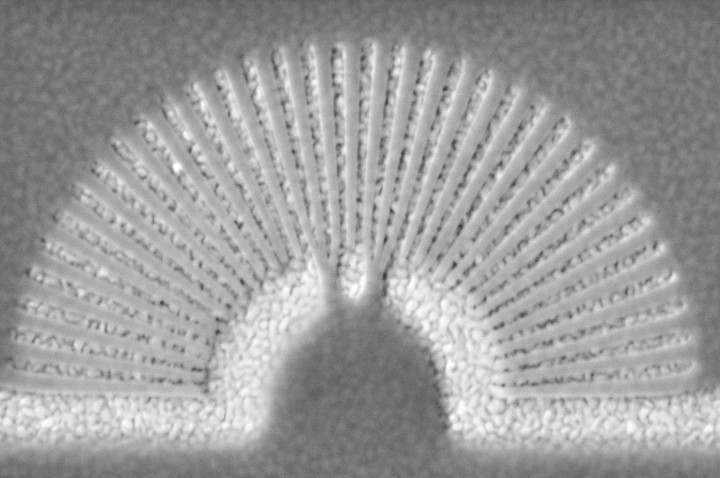Hyperlens to Enable Hypermagnification in Optical Microscopy


The image (above) shows a metamaterial hyperlens. The light-colored slivers are gold and the darker ones are PMMA (a transparent thermoplastic). Light passes through the hyperlens improving the resolution of very small objects. (Img: University of Buffalo)
Scientists at the University of Buffalo are pushing the limits of microscopy with their new hyperlens. Currently in prototype stage, this new hyperlens is developed by a team of researchers from the university’s electrical engineering department headed by Professor Natalia Litchinitser.
In order to achieve unnatural magnification, the team has developed the new hyperlens using materials with unnatural properties. These artificial materials, known as metamaterials are engineered to exhibit certain properties which are currently not found in nature. The team has created this new metamaterial by using slivers of gold and a transparent thermoplastic called polymethyl methacrylate (PMMA). These slivers are organized in a radial shape instead of conventional concentric ring pattern to achieve greater magnification in visible frequency range.
Until now, the resolving power of optical magnification systems was limited to about 10,000 nanometers (in case of high resolution endoscopes). But the new visible light hyperlens can potentially increase the resolution to 250 nanometers or more. Such an improvement in resolution means that the objects which were once clearly viewable under electron microscopes can be viewed using optical microscopy systems.
Technically, the property of diffraction of light is responsible for limiting the resolution of optical systems. The metamaterial used in University of Buffalo’s hyperlens increases resolution by reducing the diffraction. Reduced diffraction is achieved by changing evanescent light waves into propagating waves of increased intensity.
The University of Buffalo’s hyperlens project is funded by United States Army Research Office and National Science Foundation. A research paper regarding the hyperlens research authored by Natalia and co-authored by Jingbo Sun and Mikhail I. Shalaev is published recently on Nature Communications.
Some of the application of hyperlenses will be in the field of medicine, optical nanolithography and single molecule sequencing. If realized, improvements in these fields will lead the way for development of next generation electronic and medical devices in addition to rapid advancements in the fields of biology, chemistry and physics.
The success of hyperlens will translate to affordable medical care and cheaper electronic devices in the near future.

